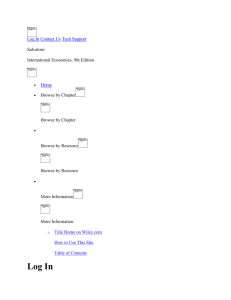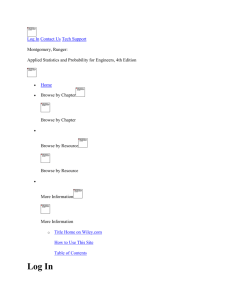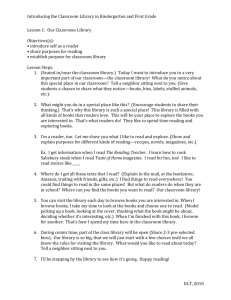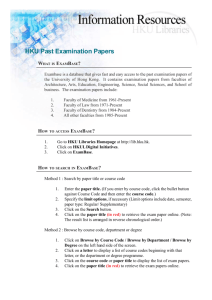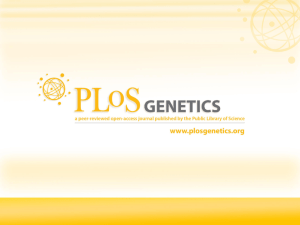Influence of Mineral Nutrition on Susceptibility and
advertisement
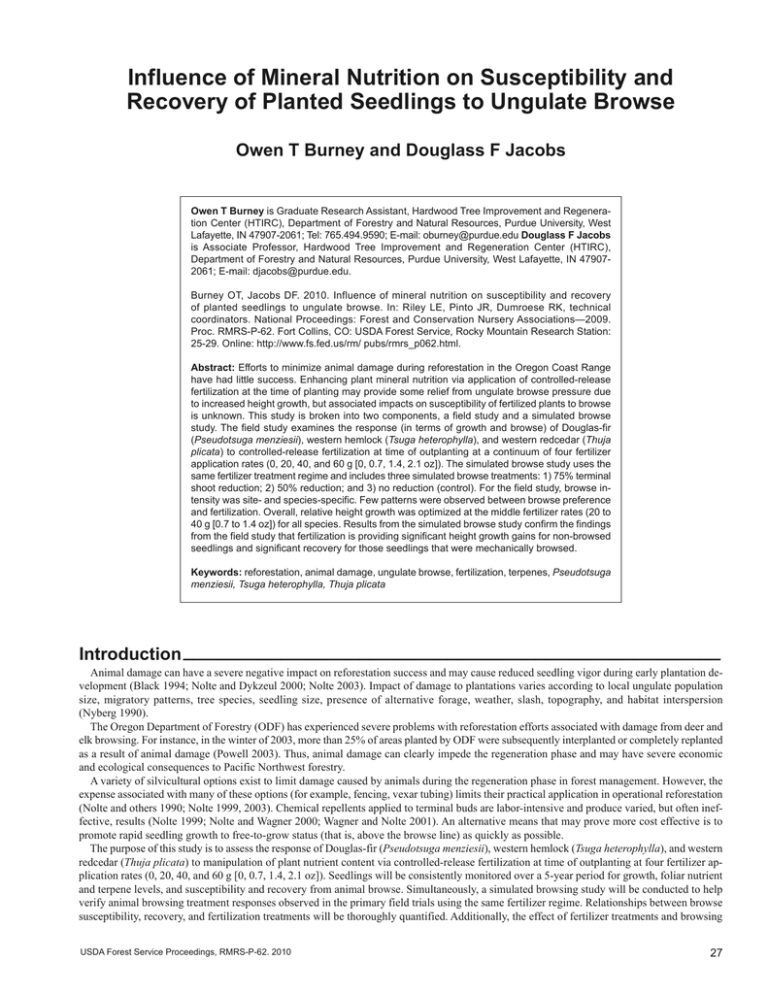
Influence of Mineral Nutrition on Susceptibility and Recovery of Planted Seedlings to Ungulate Browse Owen T Burney and Douglass F Jacobs Owen T Burney is Graduate Research Assistant, Hardwood Tree Improvement and Regeneration Center (HTIRC), Department of Forestry and Natural Resources, Purdue University, West Lafayette, IN 47907-2061; Tel: 765.494.9590; E-mail: oburney@purdue.edu Douglass F Jacobs is Associate Professor, Hardwood Tree Improvement and Regeneration Center (HTIRC), Department of Forestry and Natural Resources, Purdue University, West Lafayette, IN 479072061; E-mail: djacobs@purdue.edu. Burney OT, Jacobs DF. 2010. Influence of mineral nutrition on susceptibility and recovery of planted seedlings to ungulate browse. In: Riley LE, Pinto JR, Dumroese RK, technical coordinators. National Proceedings: Forest and Conservation Nursery Associations—2009. Proc. RMRS-P-62. Fort Collins, CO: USDA Forest Service, Rocky Mountain Research Station: 25-29. Online: http://www.fs.fed.us/rm/ pubs/rmrs_p062.html. Abstract: Efforts to minimize animal damage during reforestation in the Oregon Coast Range have had little success. Enhancing plant mineral nutrition via application of controlled-release fertilization at the time of planting may provide some relief from ungulate browse pressure due to increased height growth, but associated impacts on susceptibility of fertilized plants to browse is unknown. This study is broken into two components, a field study and a simulated browse study. The field study examines the response (in terms of growth and browse) of Douglas-fir (Pseudotsuga menziesii), western hemlock (Tsuga heterophylla), and western redcedar (Thuja plicata) to controlled-release fertilization at time of outplanting at a continuum of four fertilizer application rates (0, 20, 40, and 60 g [0, 0.7, 1.4, 2.1 oz]). The simulated browse study uses the same fertilizer treatment regime and includes three simulated browse treatments: 1) 75% terminal shoot reduction; 2) 50% reduction; and 3) no reduction (control). For the field study, browse intensity was site- and species-specific. Few patterns were observed between browse preference and fertilization. Overall, relative height growth was optimized at the middle fertilizer rates (20 to 40 g [0.7 to 1.4 oz]) for all species. Results from the simulated browse study confirm the findings from the field study that fertilization is providing significant height growth gains for non-browsed seedlings and significant recovery for those seedlings that were mechanically browsed. Keywords: reforestation, animal damage, ungulate browse, fertilization, terpenes, Pseudotsuga menziesii, Tsuga heterophylla, Thuja plicata Introduction _______________________________________________________ Animal damage can have a severe negative impact on reforestation success and may cause reduced seedling vigor during early plantation development (Black 1994; Nolte and Dykzeul 2000; Nolte 2003). Impact of damage to plantations varies according to local ungulate population size, migratory patterns, tree species, seedling size, presence of alternative forage, weather, slash, topography, and habitat interspersion (Nyberg 1990). The Oregon Department of Forestry (ODF) has experienced severe problems with reforestation efforts associated with damage from deer and elk browsing. For instance, in the winter of 2003, more than 25% of areas planted by ODF were subsequently interplanted or completely replanted as a result of animal damage (Powell 2003). Thus, animal damage can clearly impede the regeneration phase and may have severe economic and ecological consequences to Pacific Northwest forestry. A variety of silvicultural options exist to limit damage caused by animals during the regeneration phase in forest management. However, the expense associated with many of these options (for example, fencing, vexar tubing) limits their practical application in operational reforestation (Nolte and others 1990; Nolte 1999, 2003). Chemical repellents applied to terminal buds are labor-intensive and produce varied, but often ineffective, results (Nolte 1999; Nolte and Wagner 2000; Wagner and Nolte 2001). An alternative means that may prove more cost effective is to promote rapid seedling growth to free-to-grow status (that is, above the browse line) as quickly as possible. The purpose of this study is to assess the response of Douglas-fir (Pseudotsuga menziesii), western hemlock (Tsuga heterophylla), and western redcedar (Thuja plicata) to manipulation of plant nutrient content via controlled-release fertilization at time of outplanting at four fertilizer application rates (0, 20, 40, and 60 g [0, 0.7, 1.4, 2.1 oz]). Seedlings will be consistently monitored over a 5-year period for growth, foliar nutrient and terpene levels, and susceptibility and recovery from animal browse. Simultaneously, a simulated browsing study will be conducted to help verify animal browsing treatment responses observed in the primary field trials using the same fertilizer regime. Relationships between browse susceptibility, recovery, and fertilization treatments will be thoroughly quantified. Additionally, the effect of fertilizer treatments and browsing USDA Forest Service Proceedings, RMRS-P-62. 2010 27 Burney and Jacobs Influence of Mineral Nutrition on Susceptibility and Recovery of Planted Seedlings to Ungulate Browse intensity on production of plant terpenes will be examined. This information may be used to determine how variation in plant nutrition affects production of chemical plant herbivory defenses and will simultaneously yield practical, useable scientific results regarding the efficacy of silvicultural treatments that may help reduce damage and costs associated with animal browsing during the reforestation process. In this paper, we describe this ongoing project and report some preliminary results. We expect that more detailed reports will be published in the future. (May) of the primary winter browsing period. At each sampling, seedlings will be evaluated for survival and degree of browse damage (lateral and terminal shoot assessment). Evidence of foliar chlorosis, which may be indicative of nutrient stress, will also be noted. At each October sampling, seedlings will be measured for shoot height and root-collar diameter. Additionally, foliage samples will be collected from every seedling and pooled by species/block/treatment to evaluate foliar levels of both nutrients and terpenes. Materials and Methods ____________ A single site was selected in the southern region of the Tillamook District (ODF) where a total of 648 seedlings were planted for each species (Douglas-fir, western hemlock, western redcedar) in January 2007. Prior to planting, the site was prepared with an aerial herbicide application and intensive slash removal. Following these prescriptions, the site was fenced around its perimeter and trapped for mountain beaver (Figure 2). Western redcedar, Douglas-fir, and western hemlock seedlings were planted in January 2007. ODF provided the following plug stock from PRT: Douglas-fir and western hemlock plugs grown in Styroblock® 615 containers (336 ml [20.5 in3]), and western redcedar grown in Styroblock® 512 containers (220 ml [13.4 in3]). Field Browse Study Four sites were chosen for the field browse study, covering a range of the northwestern Oregon Coast Range physiographic province. These study sites (Bale Bound, Post Canyon, Yellow Bus, and Zig Zag) were installed on forest land managed by the Oregon Department of Forestry, Tillamook District. The different sites represent a range of site conditions (that is, slope, aspect, soils). A total of 960 seedlings were planted for each species (Douglas-fir, western hemlock, western redcedar) for all four sites on 5 to 8 February 2006. Hampton Tree Farms (Salem, OR) provided Douglas-fir plugs grown in Styroblock® 515 containers (250 ml [15.3 in3]) from IFA Nurseries, Incorporated (Canby, OR). ODF provided western hemlock and western redcedar plugs grown in Styroblock® 615 containers (336 ml [20.5 in3]) from Pacific Regeneration Technologies, Incorporated (Hubbard, OR). For each species, there are four fertilizer treatments in a complete randomized block design. The fertilizer treatments consist of Osmocote Exact® Lo-Start 15N:9P2O5:10K2O plus minors controlled-release fertilizer (CRF) applied at four different application rates (0, 20, 40, and 60 g [0, 0.7, 1.4, 2.1 oz]) per seedling). Fertilizer was applied with a planting tool on the uphill side of the tree 5 cm (2 in) from the stem and at a depth of 5 cm (2 in) (Figure 1). There are four fertilizer treatments and four replications per species per site. This equates to 15 seedlings per treatment per rep per species per site. Species will be analyzed separately. Prior to planting, a sub-sample of five seedlings from each species was destructively sampled to evaluate initial nutrient concentration levels and terpene levels to establish a baseline. Field measurements will be conducted twice per year, at the beginning (October) and end Simulated Browse Study Figure 2. Simulated browse study site with all large slash and residual live trees removed. A 2.4 m (8 ft) fence was constructed around the perimeter of the site, which extended 30.5 cm (12 in) into the soil. The first 0.6 m (2 ft) from the base of the fence was covered in chicken-wire to exclude rodents. The simulated browse study is a complete randomized block design examining the three separate species. There are four fertilizer treatments and three browse treatments for a total of 12 treatment combinations. With three reps and 18 seedlings per rep, there are a total of 648 seedlings per species. Species will be analyzed separately. The fertilizer treatments are the same as the field study, consisting of four different application rates (0, 20, 40, and 60 g [0, 0.7, 1.4, 2.1 oz] per seedling). At the time of planting, the simulated elk browse treatments were applied as follows: 1) no browse (control); 2) clip main stem with a 50% reduction; 3) clip main stem with 75% reduction (Figure 3). Survival, growth, and browse damage (if it occurs) of seedlings within this experiment will be measured once a year (~October) using the same protocol as the field study. Foliage samples will also be collected from every seedling and pooled by species/block/treatment to evaluate foliar levels of both nutrients and terpenes. Figure 1. Pottiputki planting tool used to deliver controlled-release fertilizer 5 cm (2 in) uphill of the seedling and 5 cm (2 in) below the soil surface. 28 USDA Forest Service Proceedings, RMRS-P-62. 2010 Influence of Mineral Nutrition on Susceptibility and Recovery of Planted Seedlings to Ungulate Browse Burney and Jacobs Trends were observed with fertilizer response; the 40 g (1.4 oz) treatment appeared to have greater mean relative height growth ([current ht - initial ht] / initial ht) compared to the other fertilizer rates, including the control. Repeated browse and severity of browse interfered greatly with fertilizer response. Mean relative height growth was used to describe not only height growth but also browse severity. After three growing seasons, western redcedar was the only species with negative relative height growth (occurring only at Post Canyon and Zig Zag). Interestingly, even in the presence of browse after three seasons, positive relative height growth was observed at Bale Bound and Yellow Bus, suggesting browse was not as severe. This may be a function of both site conditions and ungulate herd population dynamics. Douglas-fir Figure 3. Clipping of the simulated browse treatment was performed by first measuring the pre-clipped height and then determining the 50% or 75% clipping height. All foliage was grabbed from the base and pulled up to the calculated height to be clipped. Summary _______________________ Browse intensity also varied greatly for Douglas-fir between sites for all measurement periods, though was far less than that of western redcedar and western hemlock. Mortality was extremely high at Bale Bound due to site conditions (unrelated to browse) and thus was dropped from the analysis. After the first growing season, browse differed only by site; the average browse percentage was less than 10% for Yellow Bus and Zig Zag and greater than 50% for Post Canyon. By the third growing season, there were only slight increases in browse intensity at all three sites, mostly in the form of lateral damage (Figure 5). Field Browse Study For the field study, browse intensity was site- and species-specific. Differences in site may be a function of ungulate herd dynamics, which includes the number of individuals and their range of movement. Browse differences by species may be a function of plant chemical defenses in the form of terpene production. Western Redcedar Measurements after one growing season revealed high levels of browse across all sites and fertilizer treatments (Figure 4). Browse intensity (measured as the percentage of seedlings browsed) after the first growing season differed only by site. Seedlings at Bale Bound and Zig Zag had less than 70% browse, whereas Post Canyon and Yellow Bus had nearly 100% browse. By the end of the third growing season, browse intensity was approximately 100% for all sites and fertilizer treatment levels. Figure 5. Impacts from browse on Douglas-fir was far less severe than the other species. After the third growing season, most browse occurred as damage to the lateral branches. Mean relative height growth at the end of the first growing season was below 50% for all sites and fertilizer treatments. Post Canyon, having high browse pressure, revealed negative growth rates after the first season. By the third measurement period, all sites and treatment levels had positive mean relative height growth in which some trees had already grown beyond the browse height range (Figure 6). With the addition of fertilizer, regardless of rate, general trends in relative height growth gains were observed compared to the control (no fertilizer) for seedlings at all sites. A possible toxicity effect was observed under the 60 g (2.1 oz) fertilizer rate; all sites showed a declining trend in relative height growth compared to the 20 and 40 g (0.7 and 1.4 oz) rates. Figure 4. Typical browse intensity and severity of western redcedar after three growing seasons. Half of the field sites resulted in negative relative height growth. USDA Forest Service Proceedings, RMRS-P-62. 2010 Western Hemlock Soil conditions at the Zig Zag site were extremely harsh due to buried slash, resulting in almost 100% mortality. For this reason, 29 Burney and Jacobs Influence of Mineral Nutrition on Susceptibility and Recovery of Planted Seedlings to Ungulate Browse Zig Zag was removed from the analysis. Similar to western redcedar and Douglas-fir, western hemlock browse intensity varied greatly between sites, ranging between 10% and 75% after the first growing season. By the third season, browse intensity nearly doubled for each site (Figure 7). No trends were observed between browse intensity and fertilizer rate. At the end of the first growing season, mean relative height for all sites and treatment levels was below 50%. There were no negative growth rates after this first season, suggesting browse was not as severe as was observed with western redcedar and Douglas-fir. Substantial relative height growth was observed at the end of the third growing season at both Post Canyon and Yellow Bus; growth rates exceeded 150% for all treatment levels. A combination of heavy browse pressure and site conditions at Bale Bound may have contributed to lower growth rates (range of 50% to 100%) compared to the other sites. At the end of the third growing season, the 20 g (0.7 oz) fertilizer treatment appeared to outperform all other fertilizer levels, including the control. This trend was similar to that observed with western redcedar and Douglas-fir in that the middle fertilizer levels (20 to 40 g [0.7 to 1.4 oz]) provided height growth gains up to 8.5 times that of the control. Simulated Browse Study After two growing seasons, the simulated browse study revealed positive relative growth response under all fertilizer and browse treatments. This differs from the field study, which has shown, and continues to show, negative growth for some species and some sites. This negative growth in the field is a function of repeated browse. Western Redcedar Figure 6. Outstanding height growth of Douglas-fir with minimal to no browse at the Zig Zag site after three growing seasons. Second growing season results for mean relative height growth were similar to those found one year after planting. Fertilization, regardless of rate, showed gains in relative height growth relative to the control. Trends suggest that greater gains were achieved at the higher fertilizer rates (40 and 60 g [1.4 and 2.1 oz]). As anticipated, simulated browse treatments resulted in significant differences in mean relative height growth. The gains from fertilization and lack of interaction between treatments suggest that fertilization is aiding in recovery from browse. Douglas-fir Fertilization appeared to also aid in the recovery from browse after the second growing season of Douglas-fir seedlings. The greatest gains in relative height growth were observed under the 20 g (0.7 oz) treatment. These gains were more evident under the 75% reduction level. Beyond the 20 g (0.7 oz) rate, there was a decreasing trend toward the 60 g (2.1 oz) rate, suggesting potential toxicity effects. Western Hemlock Compared to the control fertilizer treatment (0 g), there was a steady increase in mean relative height growth with increasing fertilizer rate. Height growth was maximized at the 60 g (2.1 oz) rate, which differed from the findings in the field study. Again, there were obvious differences between the simulated browse treatment levels. Terpene Analysis Currently, terpene analyses have only been performed on baseline seedlings (prior to treatment application) due to the complexity of the methodology/preparation and the time consuming process of gas chromatography-mass spectrometry (GC-MS). Future reports will have a strong focus on terpene responses to browse and fertilization. Figure 7. Extreme browse damage of western hemlock after three growing seasons. 30 USDA Forest Service Proceedings, RMRS-P-62. 2010 Influence of Mineral Nutrition on Susceptibility and Recovery of Planted Seedlings to Ungulate Browse Conclusions _____________________ Results from both studies suggest that fertilization is providing significant gains in terms of both growth and recovery. Examining the influence of browse and plant mineral nutrition on the production of plant chemical defense (terpenes) is a part of this study and will contribute to better understand those specific factors driving browse susceptibility and recovery. Acknowledgments________________ This study was funded by the Oregon Department of Forestry. We appreciate the assistance of K Powell, J Travers, D Robin, and J Brant for helping to develop and fund the project. For their field work and analyses contributions, we would like to acknowledge J Sloan, M Selig, P Woolery, R Morrissey, R Goodman, and K Wood. Lastly, we thank AS Davis for providing the opportunity to present this information to the Western Forest and Conservation Nursery Association. References ______________________ Black HC, technical editor. 1994. Animal damage management handbook. Portland (OR): USDA Forest Service, Pacific Northwest Research Station. General Technical Report PNW-GTR-332. 236 p. Nolte D. 1999. Behavioral approaches for limiting depredation by wild ungulates. In: Launchbaugh KL, Sanders K, Mosley J, editors. Grazing Burney and Jacobs behaviour of livestock and wildlife. Moscow (ID): University of Idaho, Idaho Forest, Wildlife, and Range Experiment Station. Bulletin #70. 6 p. Nolte D. 2003. Managing ungulates to protect trees. Western Forester 48:14. Nolte DL, Dykzeul M. 2000. Wildlife impacts on forest resources. In: Clark L, Hone J, Shivik JA, Watkins RA, VerCauteren KC, Yoder JK, editors. Human conflicts with wildlife: economic considerations. Proceedings of the 3rd NWRC Special Symposium. Fort Collins (CO): National Wildlife Research Center. p 163-268. Nolte DL, Wagner KK. 2000. Comparing the efficacy of delivery systems and active ingredients of deer repellents. In: Salmon TP, Crabb AC, editors. Proceeding of the Nineteenth Vertebrate Pest Conference; 2000 March 6-9; San Diego, CA. Davis (CA): University of California. VPC2000. p 93-100. Nolte DL, Provenza FD, Balph DF. 1990. The establishment and persistence of food preferences in lambs exposed to selected foods. Journal of Animal Science 68(4):998-1002. Nyberg J. 1990. Chapter 4. Interactions of timber management with deer and elk. In: Nyberg JB, Janz DW, technical editors. Deer and elk habitats in coastal forests of southern British Columbia. Victoria (BC): British Columbia Ministry of Forests and British Columbia Ministry of Environment. Powell K. 2003. Personal communication. Tillamook (OR): Tillamook District, Oregon Department of Forestry, Reforestation Forester. Wagner KK, Nolte DL. 2001. Comparison of active ingredients and delivery systems in deer repellents. Wildlife Society Bulletin 29:322-330. The content of this paper reflects the views of the authors, who are responsible for the facts and accuracy of the information presented within. USDA Forest Service Proceedings, RMRS-P-62. 2010 31
